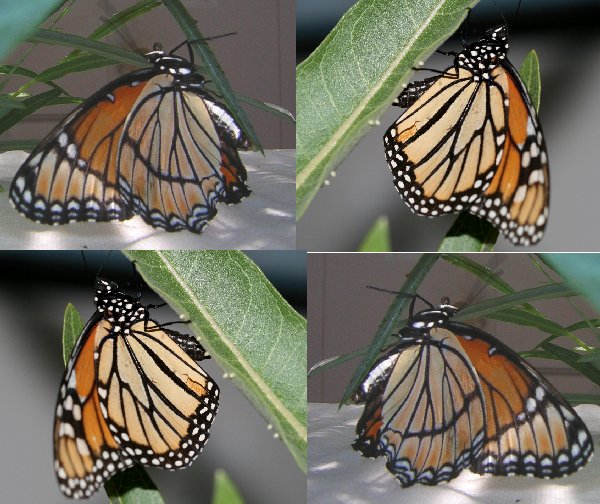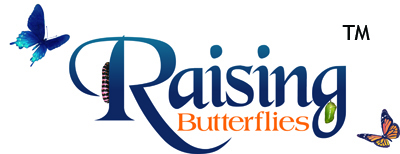Female Oviposition Techniques
 Sometimes finding eggs and caterpillars on their larval host plants can be very difficult for many reasons including caterpillar camouflage, not knowing what hostplants to look on, too much hostplant to search, etc.
Sometimes finding eggs and caterpillars on their larval host plants can be very difficult for many reasons including caterpillar camouflage, not knowing what hostplants to look on, too much hostplant to search, etc.
Another alternative is to try to capture live females and set them up in a cage or container to get them to lay eggs. Before discussing these strategies, it is important to understand some basics of how to locate and collect live females as well as how to take care of them in captivity.
Different types of containers and cages work for different groups of butterflies. This section will provide multiple picture galleries overviewing different types of cages, containers, and strategies to get females to lay eggs in captivity as applicable to certain taxa.
| modify remove |
-
Open Screen Cages
Open screen cages generally vary from roughly 12" to 24" on each side. These cages are most effective for larger butterflies such as swallowtails and brushfooted butterflies. In order to get females to oviposit in these cages you need to remember to feed the female butterflies every day. It is also helpful to keep the female in a dark, cool, closet for at least for a few days before trying to get eggs out of her in order to help get her acclamated to captivity. This technique will also increase her urge to lay eggs. When you set up your cage, be sure to place your water bottle with hostplant cuttings adjacent to the side of the cage next to your light source (preferrably filtered sunlight) so that when the female flies towards the light source, she will be in contact with her hostplant. Oftentimes, if she is ready to oviposit, touching the hostplant with her legs will trigger a response for her to lay an egg. -
High Humidity Cages
High humidity cages are similar to open screen cages; except some sort of clear plastic or cellophane needs to be fastened over each side of the cage to keep the environment humid. This works very well of admirals and viceorys (genus Limenitis.) -
Portable Cages
The term "portable cage" refers to a small, single unit I assemble for live females of smaller butterflies such as checkerspots, crescents, painted ladies, whites, and sulphurs, satyrs, and skippers. Portable cages eliminate the setup/break down time of the open screen cages and can come in handy on when you're looking to get eggs out of butterfly females while traveling. To use a portable cage, simply poor some water into the bottom of the cage and wipe down with paper towel (so the female doesn't get her wings stuck at the bottom of the cage. Place cuttings of the larval hostplant in the holes. -
Potted Plant Sleeves
Another option of obtaining eggs out of live females is placing nylon net sleeves,paint strainers, and/or cylindrical screens right over potted plants. This self-contained setup not only allows you to get eggs out of females; but also allows you to continue to rear the immatures without necessarily worrying about finding and hatching the eggs and/or rearing them in a separate setup. All you need to do is water the plant and expose to suitable light. -
Small Squat Tub
Setting up smaller butterflies such as lycaenids and some skippers in larger cages can become a problem in terms of locating the female and/or the eggs afterwards. Some lycaenid females prefer to strategically tuck or hide their eggs. This creates a situation where a smaller setup like the small squat tub is helpful. -
Twin Cup Method
Setting up females using the twin cup method is relatively simple. Drill holes on the bottom of a 16 ounce squat tub and place host plant sprigs down through the holes. Fill a 32 ounce plastic cup roughly 3/4 full of water and place the squat tub inside the larger cup. (The hostplant stalks will then be in water.) Place a nylon mesh lid on top.
Using the twin cup method works well with lycaenids where it is necessary to keep blooms intact as long as possible. The genus that benefits from this method is the Euphilotes blues. Because blooming buckwheat serves both as a larval host plant AND an adult nectar source, simply place females inside; and allow them to oviposit for days.
Using this method is especially helpful for Euphilotes ancilla; as females prefer to oviposit mainly on the open flower petals. (John Emmel) Please see this video for more information.
-
Brown Bag
Some species of butterflies overwinter as unfed first instars or eggs. Females from these species groups which include greater fritillaries, arctics, alpines (and other satyrs), lesser fritillaries, parnassians, and some giant skippers will lay their eggs haphazardly near host plants as hatchling larvae will not initiate feeding until next spring.
That being the case, you can set up these females in brown bags with dead host and they will lay eggs either on dead host or on the bag itself facilitating the process of getting eggs. These females do not necessarily need a lot of light to trigger oviposition. For example, placing a live fritillary female with dead violets and a nectar source oftentimes works well.


